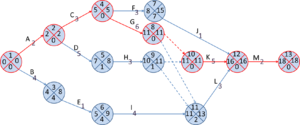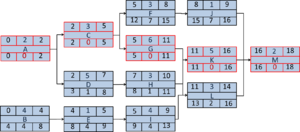Arrow diagram
Arrow diagram is a tool that graphically describes the relationship between planned activities, which make up the execution of a particular project. It graphically (visually) represents a deliberate plan of work, paying attention to the critical operations and inventory time. This technique is related to critical path analysis.
It is one of new 7 quality tools together with affinity diagram, relations diagram, matrix diagram, matrix data analysis, tree diagram, process decision programme chart.
Other names of the tool:
- Network diagram
- Network operations
- Network diagram of steps
General rules
- Specify a list of actions necessary to complete a task (planning activities)
- Determine the interdependence of activities, such as mutual entailment (the action in order)
- Predict the time needed to implement the whole project, by estimating the duration of individual activities (with the adoption of the same unit of time)
Procedure
- Define the proposed project (e.g. to determine the beginning and end of project)
- Define a list of actions necessary to proceed with the project
- Estimate duration (execution) of the individual steps (should be the same unit of time)
- Define the order of occurrence of these steps (some steps may be performed simultaneously)
- Draw a diagram (network operations) (depending on the type of network should be drawn to mark the vertices and arrows, part of the graph operations and the execution time of each of them, sometimes supplemented with a diagram for additional information, such as the earliest and latest dates for commencement of operations, the unit responsible for their execution, etc.)
- The diagram analysis
- Define inventory time for each activity
- The designation of the critical path (longest path in the network, which determines the shortest possible time of completion of the project, in which there are critical steps, i.e. those that have no slack time)
- Calculate the time needed to complete the entire project
- Analyse the measures that should be used to implement the project within
See also:
Examples of Arrow diagram
- A common example of an Arrow diagram is in the construction of a house. In this case, the main activities are represented by arrows that point from one activity to the next. For instance, the first activity could be excavation and the second activity could be laying the foundation. Other activities such as framing, siding, insulation, and drywall could follow in sequence. Each activity would be represented by an arrow with a specific timeline associated with it.
- Another example of an Arrow diagram is in the manufacturing of a car. In this case, the main activities would include ordering parts, assembling the engine, and painting. Again, each activity would be represented by an arrow with a timeline associated with it.
- A third example of an Arrow diagram is in the design of a website. In this case, the main activities would include designing the layout, writing the code, and testing the website. Again, each activity would be represented by an arrow with a timeline associated with it.
Advantages of Arrow diagram
- Arrow diagrams are simple and easy to understand visual representation of the sequence of activities and their inter-dependencies.
- Arrow diagrams provide a clear indication of the dependencies between tasks, allowing for the critical path to be identified easily.
- Arrow diagrams enable the user to identify potential problems before the project begins, allowing for corrective actions to be taken.
- They are an effective way of tracking progress on a project, as the progress of each task can be monitored.
- Arrow diagrams also help to identify and resolve any conflicts between tasks in the project.
- They are flexible and can be adjusted throughout the project if the scope or timeline of the project changes.
Limitations of Arrow diagram
- Arrow diagrams are limited in their ability to provide information about the individual activities and tasks of a project.
- They do not provide the ability to simulate the effects of changes in the project, such as changes in resources, delays, and costs.
- It is difficult to determine the duration of each activity from the diagram.
- The diagrams do not account for logical dependencies between activities, making it difficult to determine the project's critical path.
- It can be difficult to track the progress of activities with an arrow diagram as it does not provide real-time updates on the status of activities.
- Arrow diagrams cannot be used to estimate the resources needed for a project or determine the most cost-effective way to complete the project.
In project management, there are other approaches related to Arrow Diagram that can be used to evaluate project performance. These are:
- Critical Path Method (CPM): This is a project management tool that is used to plan and monitor the progress of a project. It involves the use of a network diagram to identify the critical tasks and activities that must be completed on time in order to complete the project on schedule.
- Program Evaluation and Review Technique (PERT): This is a project management technique that is used to analyze the tasks and activities of a project. It uses a network diagram to identify the critical tasks and activities and their dependencies.
- Gantt Charts: These are graphical representations of a project's timeline and tasks. They are used to track the progress of a project and to identify tasks that need to be completed in order to meet a project's goals.
- Activity Network Diagram: This is a graphical representation of the activities and tasks that make up a project. It is used to identify the dependencies between tasks and the critical path.
In summary, Arrow Diagram is a project management technique used to graphically represent the relationships between planned activities of a project. Other approaches related to Arrow Diagram include Critical Path Method, Program Evaluation and Review Technique, Gantt Charts, and Activity Network Diagram.
| Arrow diagram — recommended articles |
| Baseline schedule — Work breakdown structure (WBS) — Earned value analysis — Activity network diagram — Network charts — Software cost estimation — Critical path method — Sprint backlog — Subproject |
References
- Salih O. Duffuaa, Mohamed Ben‐Daya, (1995) Improving maintenance quality using SPC tools, Journal of Quality in Maintenance Engineering, Vol. 1 Iss: 2
Author: Patrycja Celej

